Management Accounting Report: Analysis of Agmet's Financials
VerifiedAdded on 2020/01/16
|20
|6546
|197
Report
AI Summary
This report examines management accounting practices for Agmet, a chemical manufacturing company, focusing on cost accounting systems, financial reporting methods, and budgetary control. It analyzes different types of management accounting systems and their essential requirements, evaluating their benefits and application within Agmet. The report includes the preparation and interpretation of income statements using absorption and marginal costing techniques, along with an analysis of planning tools used for budgetary control. It further evaluates how these tools address financial problems and contribute to organizational success, comparing how organizations adapt management accounting systems to respond to financial challenges. The report provides a comprehensive overview of management accounting principles and their practical application within a business context.
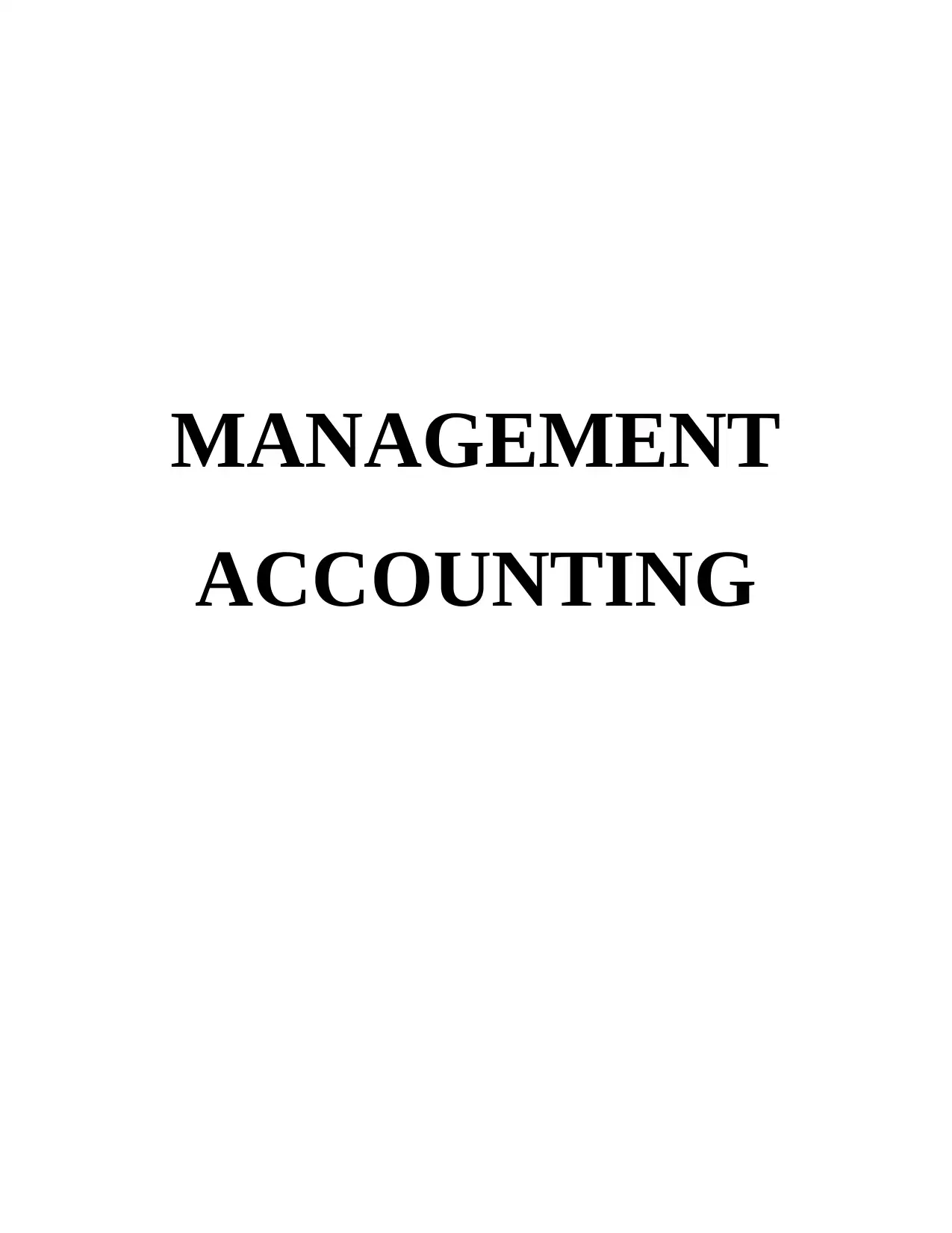
MANAGEMENT
ACCOUNTING
ACCOUNTING
Paraphrase This Document
Need a fresh take? Get an instant paraphrase of this document with our AI Paraphraser
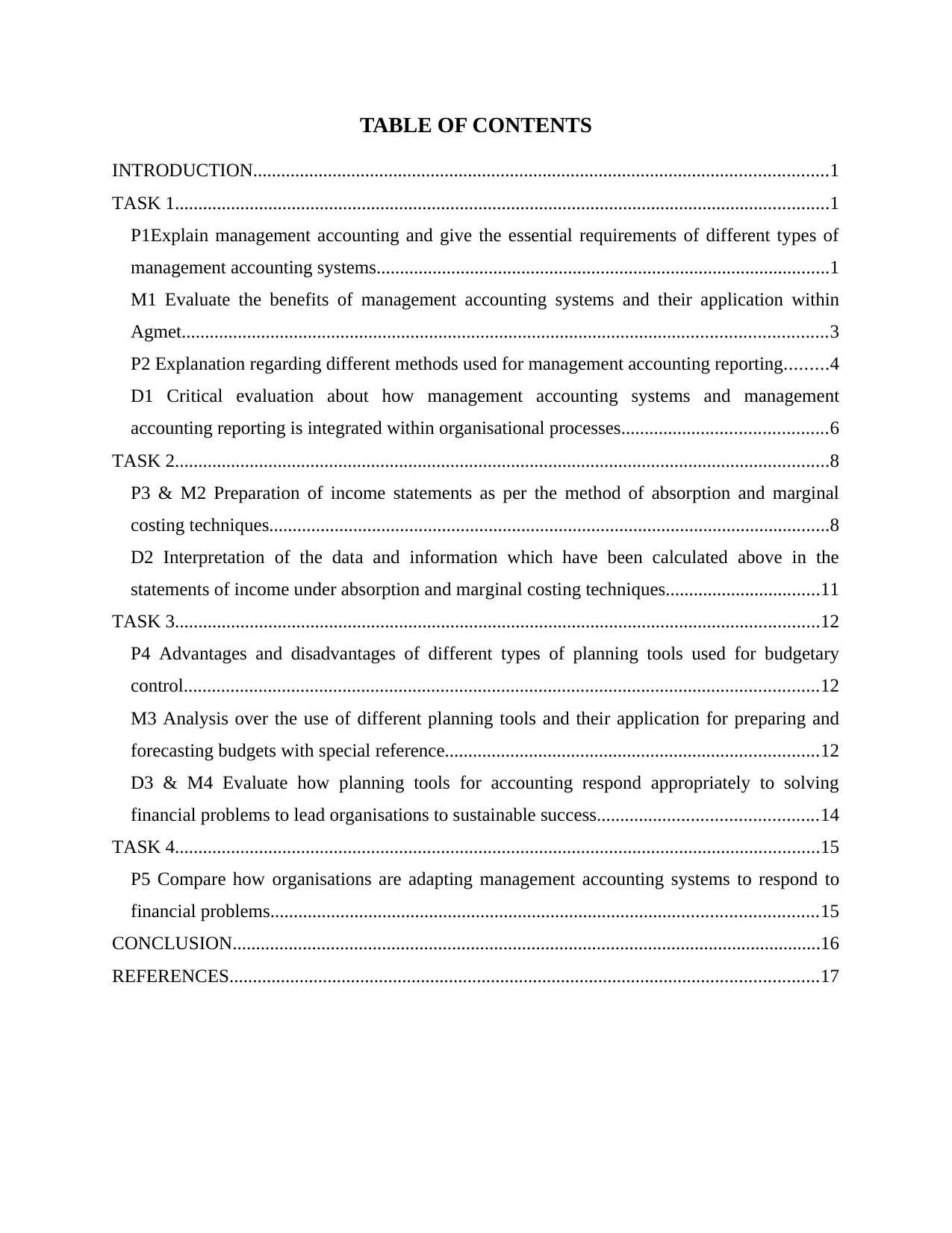
TABLE OF CONTENTS
INTRODUCTION...........................................................................................................................1
TASK 1............................................................................................................................................1
P1Explain management accounting and give the essential requirements of different types of
management accounting systems.................................................................................................1
M1 Evaluate the benefits of management accounting systems and their application within
Agmet..........................................................................................................................................3
P2 Explanation regarding different methods used for management accounting reporting.........4
D1 Critical evaluation about how management accounting systems and management
accounting reporting is integrated within organisational processes............................................6
TASK 2............................................................................................................................................8
P3 & M2 Preparation of income statements as per the method of absorption and marginal
costing techniques........................................................................................................................8
D2 Interpretation of the data and information which have been calculated above in the
statements of income under absorption and marginal costing techniques.................................11
TASK 3..........................................................................................................................................12
P4 Advantages and disadvantages of different types of planning tools used for budgetary
control........................................................................................................................................12
M3 Analysis over the use of different planning tools and their application for preparing and
forecasting budgets with special reference................................................................................12
D3 & M4 Evaluate how planning tools for accounting respond appropriately to solving
financial problems to lead organisations to sustainable success...............................................14
TASK 4..........................................................................................................................................15
P5 Compare how organisations are adapting management accounting systems to respond to
financial problems.....................................................................................................................15
CONCLUSION..............................................................................................................................16
REFERENCES..............................................................................................................................17
INTRODUCTION...........................................................................................................................1
TASK 1............................................................................................................................................1
P1Explain management accounting and give the essential requirements of different types of
management accounting systems.................................................................................................1
M1 Evaluate the benefits of management accounting systems and their application within
Agmet..........................................................................................................................................3
P2 Explanation regarding different methods used for management accounting reporting.........4
D1 Critical evaluation about how management accounting systems and management
accounting reporting is integrated within organisational processes............................................6
TASK 2............................................................................................................................................8
P3 & M2 Preparation of income statements as per the method of absorption and marginal
costing techniques........................................................................................................................8
D2 Interpretation of the data and information which have been calculated above in the
statements of income under absorption and marginal costing techniques.................................11
TASK 3..........................................................................................................................................12
P4 Advantages and disadvantages of different types of planning tools used for budgetary
control........................................................................................................................................12
M3 Analysis over the use of different planning tools and their application for preparing and
forecasting budgets with special reference................................................................................12
D3 & M4 Evaluate how planning tools for accounting respond appropriately to solving
financial problems to lead organisations to sustainable success...............................................14
TASK 4..........................................................................................................................................15
P5 Compare how organisations are adapting management accounting systems to respond to
financial problems.....................................................................................................................15
CONCLUSION..............................................................................................................................16
REFERENCES..............................................................................................................................17
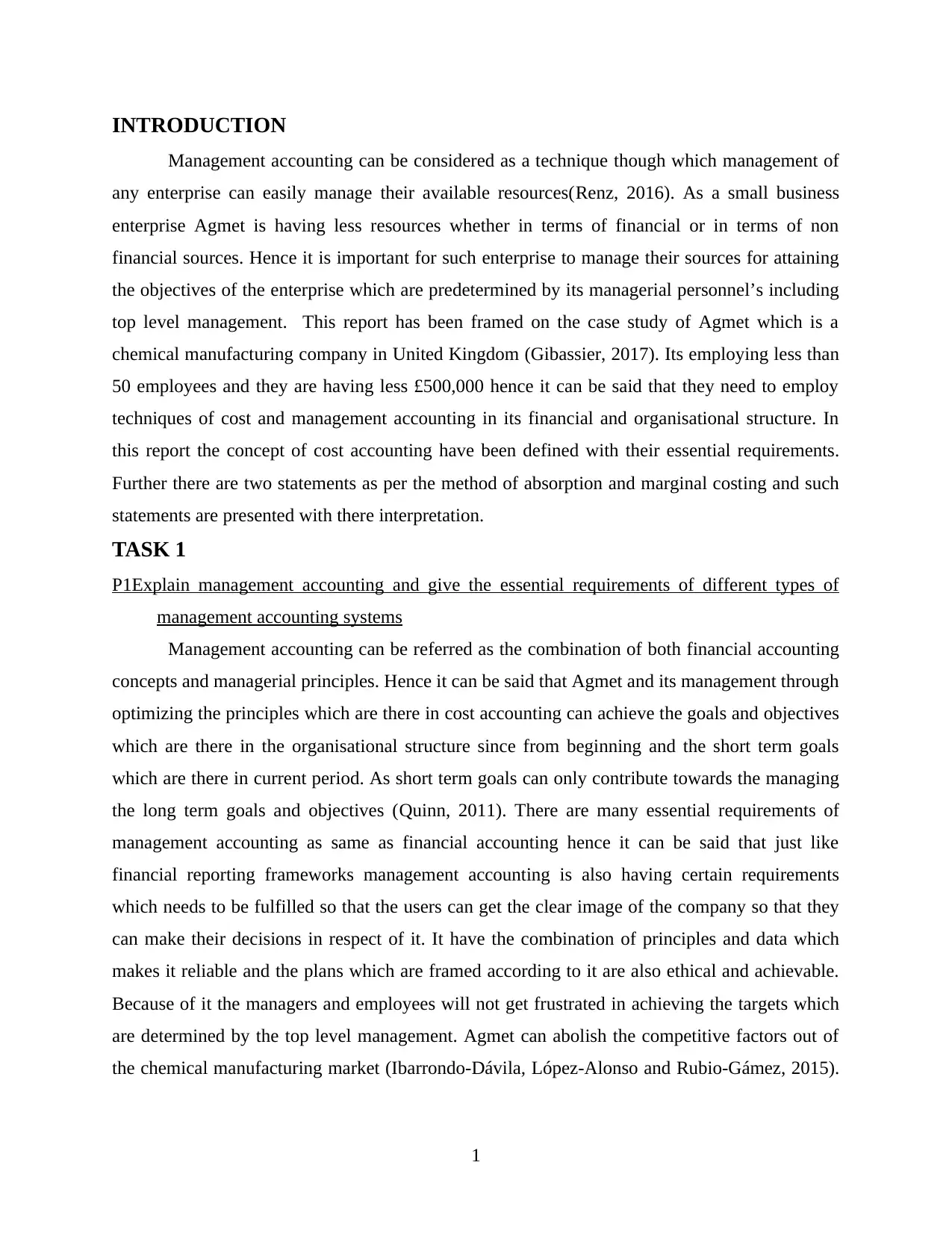
INTRODUCTION
Management accounting can be considered as a technique though which management of
any enterprise can easily manage their available resources(Renz, 2016). As a small business
enterprise Agmet is having less resources whether in terms of financial or in terms of non
financial sources. Hence it is important for such enterprise to manage their sources for attaining
the objectives of the enterprise which are predetermined by its managerial personnel’s including
top level management. This report has been framed on the case study of Agmet which is a
chemical manufacturing company in United Kingdom (Gibassier, 2017). Its employing less than
50 employees and they are having less £500,000 hence it can be said that they need to employ
techniques of cost and management accounting in its financial and organisational structure. In
this report the concept of cost accounting have been defined with their essential requirements.
Further there are two statements as per the method of absorption and marginal costing and such
statements are presented with there interpretation.
TASK 1
P1Explain management accounting and give the essential requirements of different types of
management accounting systems
Management accounting can be referred as the combination of both financial accounting
concepts and managerial principles. Hence it can be said that Agmet and its management through
optimizing the principles which are there in cost accounting can achieve the goals and objectives
which are there in the organisational structure since from beginning and the short term goals
which are there in current period. As short term goals can only contribute towards the managing
the long term goals and objectives (Quinn, 2011). There are many essential requirements of
management accounting as same as financial accounting hence it can be said that just like
financial reporting frameworks management accounting is also having certain requirements
which needs to be fulfilled so that the users can get the clear image of the company so that they
can make their decisions in respect of it. It have the combination of principles and data which
makes it reliable and the plans which are framed according to it are also ethical and achievable.
Because of it the managers and employees will not get frustrated in achieving the targets which
are determined by the top level management. Agmet can abolish the competitive factors out of
the chemical manufacturing market (Ibarrondo-Dávila, López-Alonso and Rubio-Gámez, 2015).
1
Management accounting can be considered as a technique though which management of
any enterprise can easily manage their available resources(Renz, 2016). As a small business
enterprise Agmet is having less resources whether in terms of financial or in terms of non
financial sources. Hence it is important for such enterprise to manage their sources for attaining
the objectives of the enterprise which are predetermined by its managerial personnel’s including
top level management. This report has been framed on the case study of Agmet which is a
chemical manufacturing company in United Kingdom (Gibassier, 2017). Its employing less than
50 employees and they are having less £500,000 hence it can be said that they need to employ
techniques of cost and management accounting in its financial and organisational structure. In
this report the concept of cost accounting have been defined with their essential requirements.
Further there are two statements as per the method of absorption and marginal costing and such
statements are presented with there interpretation.
TASK 1
P1Explain management accounting and give the essential requirements of different types of
management accounting systems
Management accounting can be referred as the combination of both financial accounting
concepts and managerial principles. Hence it can be said that Agmet and its management through
optimizing the principles which are there in cost accounting can achieve the goals and objectives
which are there in the organisational structure since from beginning and the short term goals
which are there in current period. As short term goals can only contribute towards the managing
the long term goals and objectives (Quinn, 2011). There are many essential requirements of
management accounting as same as financial accounting hence it can be said that just like
financial reporting frameworks management accounting is also having certain requirements
which needs to be fulfilled so that the users can get the clear image of the company so that they
can make their decisions in respect of it. It have the combination of principles and data which
makes it reliable and the plans which are framed according to it are also ethical and achievable.
Because of it the managers and employees will not get frustrated in achieving the targets which
are determined by the top level management. Agmet can abolish the competitive factors out of
the chemical manufacturing market (Ibarrondo-Dávila, López-Alonso and Rubio-Gámez, 2015).
1
⊘ This is a preview!⊘
Do you want full access?
Subscribe today to unlock all pages.

Trusted by 1+ million students worldwide
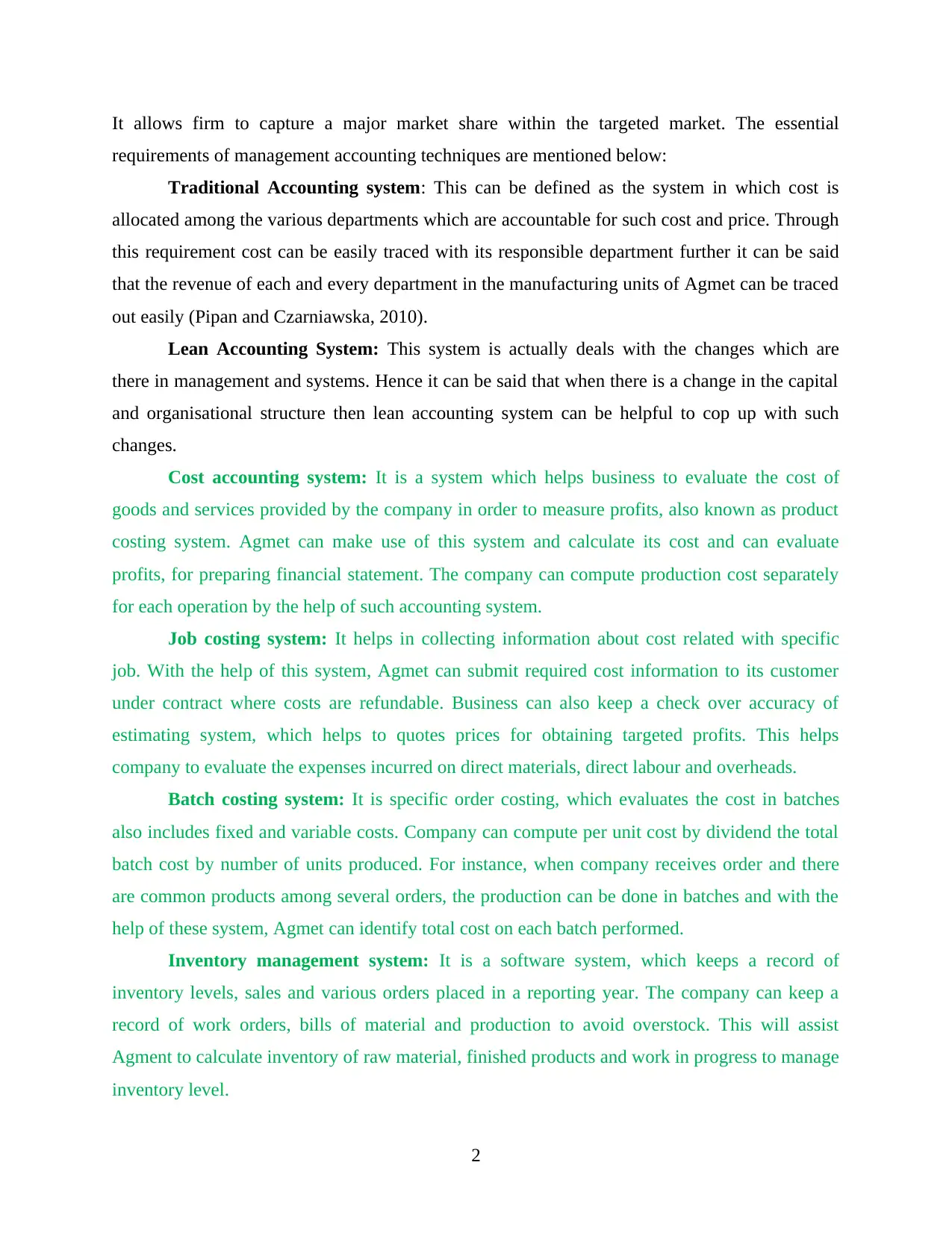
It allows firm to capture a major market share within the targeted market. The essential
requirements of management accounting techniques are mentioned below:
Traditional Accounting system: This can be defined as the system in which cost is
allocated among the various departments which are accountable for such cost and price. Through
this requirement cost can be easily traced with its responsible department further it can be said
that the revenue of each and every department in the manufacturing units of Agmet can be traced
out easily (Pipan and Czarniawska, 2010).
Lean Accounting System: This system is actually deals with the changes which are
there in management and systems. Hence it can be said that when there is a change in the capital
and organisational structure then lean accounting system can be helpful to cop up with such
changes.
Cost accounting system: It is a system which helps business to evaluate the cost of
goods and services provided by the company in order to measure profits, also known as product
costing system. Agmet can make use of this system and calculate its cost and can evaluate
profits, for preparing financial statement. The company can compute production cost separately
for each operation by the help of such accounting system.
Job costing system: It helps in collecting information about cost related with specific
job. With the help of this system, Agmet can submit required cost information to its customer
under contract where costs are refundable. Business can also keep a check over accuracy of
estimating system, which helps to quotes prices for obtaining targeted profits. This helps
company to evaluate the expenses incurred on direct materials, direct labour and overheads.
Batch costing system: It is specific order costing, which evaluates the cost in batches
also includes fixed and variable costs. Company can compute per unit cost by dividend the total
batch cost by number of units produced. For instance, when company receives order and there
are common products among several orders, the production can be done in batches and with the
help of these system, Agmet can identify total cost on each batch performed.
Inventory management system: It is a software system, which keeps a record of
inventory levels, sales and various orders placed in a reporting year. The company can keep a
record of work orders, bills of material and production to avoid overstock. This will assist
Agment to calculate inventory of raw material, finished products and work in progress to manage
inventory level.
2
requirements of management accounting techniques are mentioned below:
Traditional Accounting system: This can be defined as the system in which cost is
allocated among the various departments which are accountable for such cost and price. Through
this requirement cost can be easily traced with its responsible department further it can be said
that the revenue of each and every department in the manufacturing units of Agmet can be traced
out easily (Pipan and Czarniawska, 2010).
Lean Accounting System: This system is actually deals with the changes which are
there in management and systems. Hence it can be said that when there is a change in the capital
and organisational structure then lean accounting system can be helpful to cop up with such
changes.
Cost accounting system: It is a system which helps business to evaluate the cost of
goods and services provided by the company in order to measure profits, also known as product
costing system. Agmet can make use of this system and calculate its cost and can evaluate
profits, for preparing financial statement. The company can compute production cost separately
for each operation by the help of such accounting system.
Job costing system: It helps in collecting information about cost related with specific
job. With the help of this system, Agmet can submit required cost information to its customer
under contract where costs are refundable. Business can also keep a check over accuracy of
estimating system, which helps to quotes prices for obtaining targeted profits. This helps
company to evaluate the expenses incurred on direct materials, direct labour and overheads.
Batch costing system: It is specific order costing, which evaluates the cost in batches
also includes fixed and variable costs. Company can compute per unit cost by dividend the total
batch cost by number of units produced. For instance, when company receives order and there
are common products among several orders, the production can be done in batches and with the
help of these system, Agmet can identify total cost on each batch performed.
Inventory management system: It is a software system, which keeps a record of
inventory levels, sales and various orders placed in a reporting year. The company can keep a
record of work orders, bills of material and production to avoid overstock. This will assist
Agment to calculate inventory of raw material, finished products and work in progress to manage
inventory level.
2
Paraphrase This Document
Need a fresh take? Get an instant paraphrase of this document with our AI Paraphraser
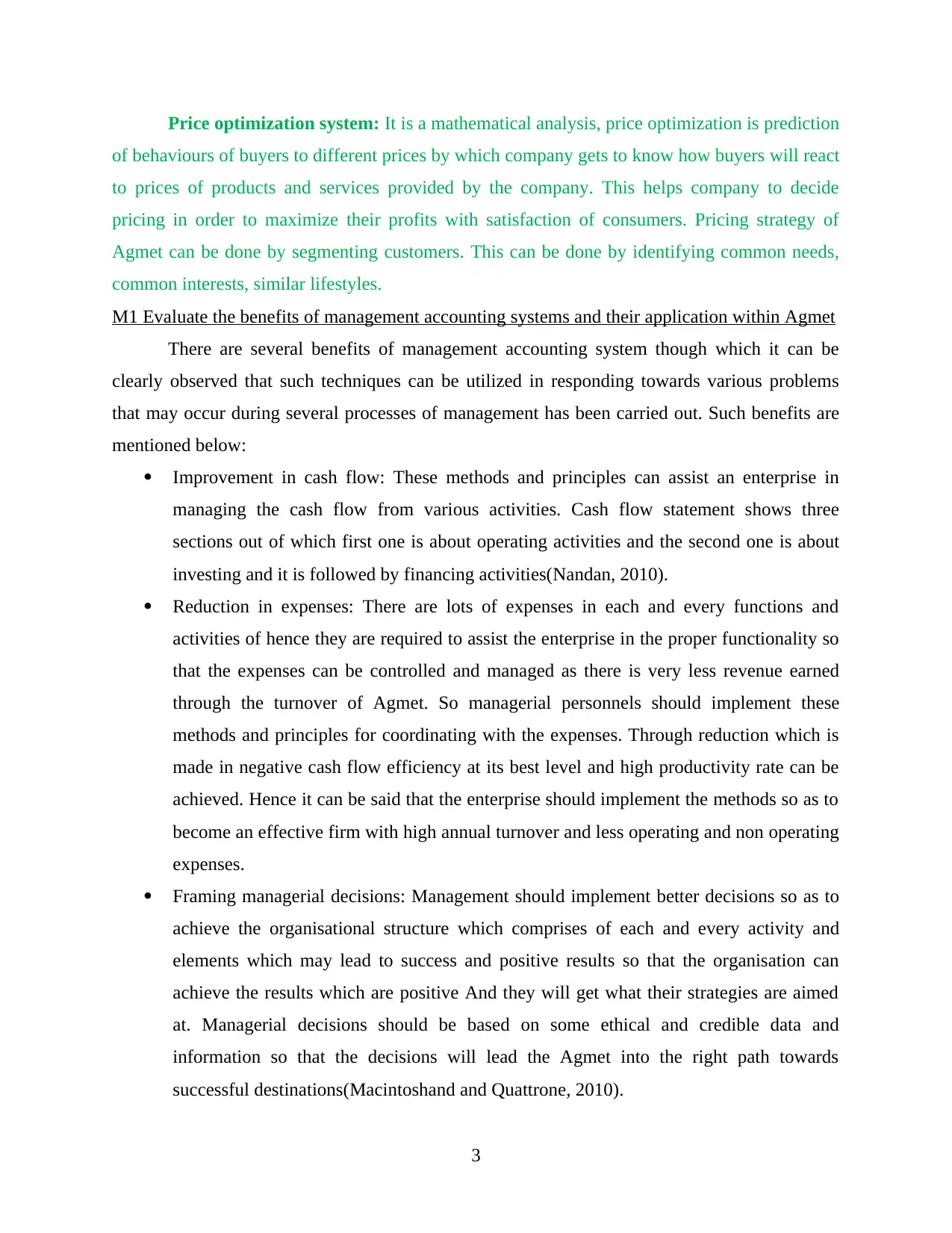
Price optimization system: It is a mathematical analysis, price optimization is prediction
of behaviours of buyers to different prices by which company gets to know how buyers will react
to prices of products and services provided by the company. This helps company to decide
pricing in order to maximize their profits with satisfaction of consumers. Pricing strategy of
Agmet can be done by segmenting customers. This can be done by identifying common needs,
common interests, similar lifestyles.
M1 Evaluate the benefits of management accounting systems and their application within Agmet
There are several benefits of management accounting system though which it can be
clearly observed that such techniques can be utilized in responding towards various problems
that may occur during several processes of management has been carried out. Such benefits are
mentioned below:
Improvement in cash flow: These methods and principles can assist an enterprise in
managing the cash flow from various activities. Cash flow statement shows three
sections out of which first one is about operating activities and the second one is about
investing and it is followed by financing activities(Nandan, 2010).
Reduction in expenses: There are lots of expenses in each and every functions and
activities of hence they are required to assist the enterprise in the proper functionality so
that the expenses can be controlled and managed as there is very less revenue earned
through the turnover of Agmet. So managerial personnels should implement these
methods and principles for coordinating with the expenses. Through reduction which is
made in negative cash flow efficiency at its best level and high productivity rate can be
achieved. Hence it can be said that the enterprise should implement the methods so as to
become an effective firm with high annual turnover and less operating and non operating
expenses.
Framing managerial decisions: Management should implement better decisions so as to
achieve the organisational structure which comprises of each and every activity and
elements which may lead to success and positive results so that the organisation can
achieve the results which are positive And they will get what their strategies are aimed
at. Managerial decisions should be based on some ethical and credible data and
information so that the decisions will lead the Agmet into the right path towards
successful destinations(Macintoshand and Quattrone, 2010).
3
of behaviours of buyers to different prices by which company gets to know how buyers will react
to prices of products and services provided by the company. This helps company to decide
pricing in order to maximize their profits with satisfaction of consumers. Pricing strategy of
Agmet can be done by segmenting customers. This can be done by identifying common needs,
common interests, similar lifestyles.
M1 Evaluate the benefits of management accounting systems and their application within Agmet
There are several benefits of management accounting system though which it can be
clearly observed that such techniques can be utilized in responding towards various problems
that may occur during several processes of management has been carried out. Such benefits are
mentioned below:
Improvement in cash flow: These methods and principles can assist an enterprise in
managing the cash flow from various activities. Cash flow statement shows three
sections out of which first one is about operating activities and the second one is about
investing and it is followed by financing activities(Nandan, 2010).
Reduction in expenses: There are lots of expenses in each and every functions and
activities of hence they are required to assist the enterprise in the proper functionality so
that the expenses can be controlled and managed as there is very less revenue earned
through the turnover of Agmet. So managerial personnels should implement these
methods and principles for coordinating with the expenses. Through reduction which is
made in negative cash flow efficiency at its best level and high productivity rate can be
achieved. Hence it can be said that the enterprise should implement the methods so as to
become an effective firm with high annual turnover and less operating and non operating
expenses.
Framing managerial decisions: Management should implement better decisions so as to
achieve the organisational structure which comprises of each and every activity and
elements which may lead to success and positive results so that the organisation can
achieve the results which are positive And they will get what their strategies are aimed
at. Managerial decisions should be based on some ethical and credible data and
information so that the decisions will lead the Agmet into the right path towards
successful destinations(Macintoshand and Quattrone, 2010).
3

Financial Planning : through implementation of the techniques and methods of financial
and cost accounting, management can introduce better cost structure which can be
considered as the optimum capital composition. In optimum capital structure the
financial resources are having less obligations but they are capable enough to generate
high returns in accordance with the plans and strategies which were previously
determined by the top level management of the cited firm.
P2 Explanation regarding different methods used for management accounting reporting
There are several methods which can be used by the cited enterprise for the management
of business affairs and to get the right return which have been estimated and observed by the top
level management of Agmet. Finally it can be said that the different methods which are used for
the financial reporting can help the management and other team who are responsible and
accountable for the preparation of the financial statements. As these methods presents the results
which are more credible and reliable hence they can predict the future image of enterprise and it
is the basic objective of financial reporting and its framework. There are several methods of
financial paling and reporting and these methods are mentioned below in detail with their
detailed features.
Job cost report: It is used to evaluate incur cost of organization from particular jobs. It
also compares actual cost and estimated cost in order to show profit margins. Agmet’s
manager can maintain these reports to avoid waste of resources and allocating resources.
It also helps to keep an eye on sales recovery, work in progress, value added and profit
summary.
Sales reports: A data maintained of calls made and sale of products and services during
specific period of time by manager or sales person. Daily check over sales cycle is a long
and complicated process that is why Agmet's sales manager can maintain sales report to
keep a track of customers interested, success rate, campaigning and closing rate.
Accounts receivable reports (AR): It is account receivable aging, data that file unpaid
customer invoices and unused credit memos according to dates. The company can use
this as an indicator to determine financial health of its customers. With the help of AR,
manager can maintain a snap shot of outstanding money due from the consumer and
create right credit extending decisions.
4
and cost accounting, management can introduce better cost structure which can be
considered as the optimum capital composition. In optimum capital structure the
financial resources are having less obligations but they are capable enough to generate
high returns in accordance with the plans and strategies which were previously
determined by the top level management of the cited firm.
P2 Explanation regarding different methods used for management accounting reporting
There are several methods which can be used by the cited enterprise for the management
of business affairs and to get the right return which have been estimated and observed by the top
level management of Agmet. Finally it can be said that the different methods which are used for
the financial reporting can help the management and other team who are responsible and
accountable for the preparation of the financial statements. As these methods presents the results
which are more credible and reliable hence they can predict the future image of enterprise and it
is the basic objective of financial reporting and its framework. There are several methods of
financial paling and reporting and these methods are mentioned below in detail with their
detailed features.
Job cost report: It is used to evaluate incur cost of organization from particular jobs. It
also compares actual cost and estimated cost in order to show profit margins. Agmet’s
manager can maintain these reports to avoid waste of resources and allocating resources.
It also helps to keep an eye on sales recovery, work in progress, value added and profit
summary.
Sales reports: A data maintained of calls made and sale of products and services during
specific period of time by manager or sales person. Daily check over sales cycle is a long
and complicated process that is why Agmet's sales manager can maintain sales report to
keep a track of customers interested, success rate, campaigning and closing rate.
Accounts receivable reports (AR): It is account receivable aging, data that file unpaid
customer invoices and unused credit memos according to dates. The company can use
this as an indicator to determine financial health of its customers. With the help of AR,
manager can maintain a snap shot of outstanding money due from the consumer and
create right credit extending decisions.
4
⊘ This is a preview!⊘
Do you want full access?
Subscribe today to unlock all pages.

Trusted by 1+ million students worldwide
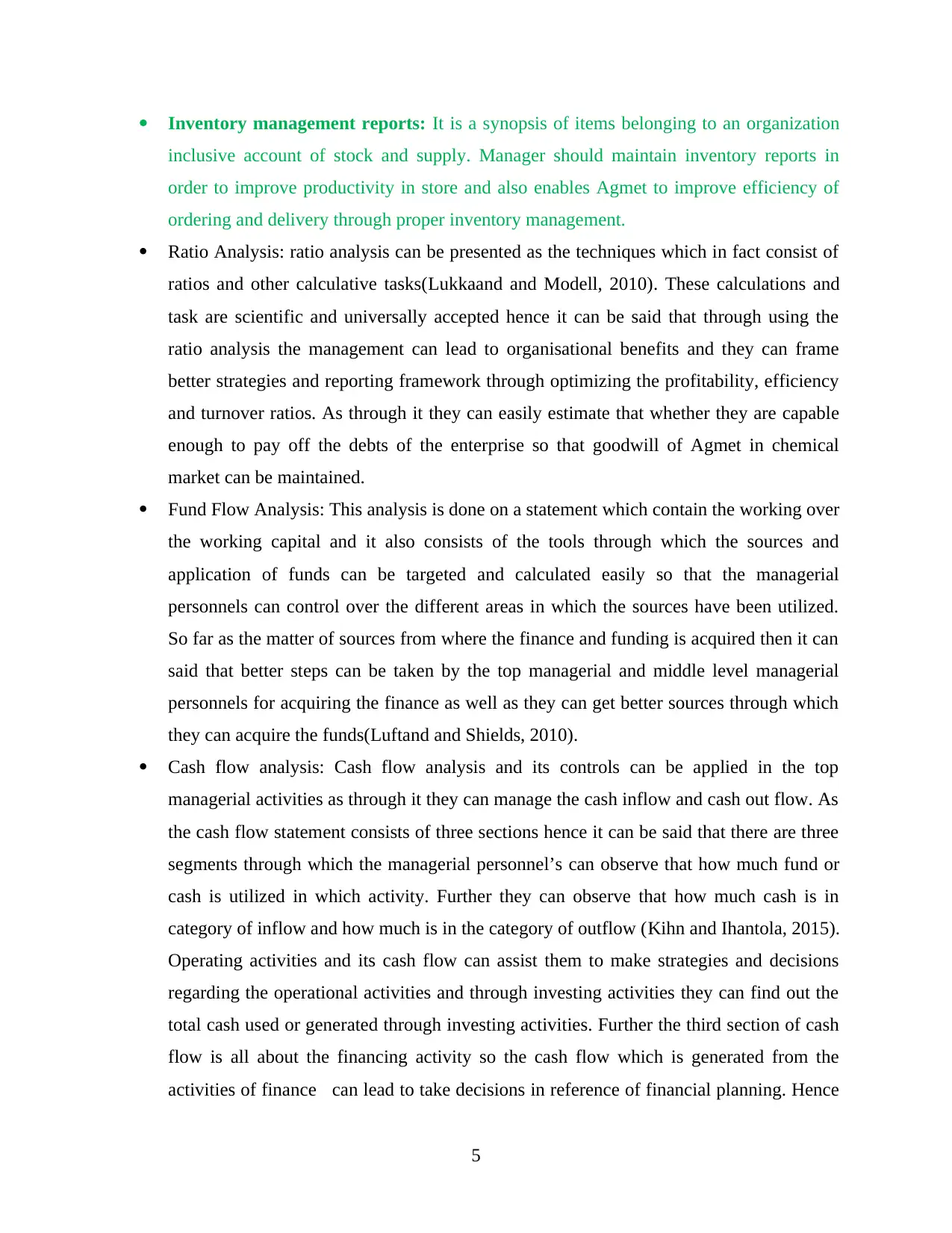
Inventory management reports: It is a synopsis of items belonging to an organization
inclusive account of stock and supply. Manager should maintain inventory reports in
order to improve productivity in store and also enables Agmet to improve efficiency of
ordering and delivery through proper inventory management.
Ratio Analysis: ratio analysis can be presented as the techniques which in fact consist of
ratios and other calculative tasks(Lukkaand and Modell, 2010). These calculations and
task are scientific and universally accepted hence it can be said that through using the
ratio analysis the management can lead to organisational benefits and they can frame
better strategies and reporting framework through optimizing the profitability, efficiency
and turnover ratios. As through it they can easily estimate that whether they are capable
enough to pay off the debts of the enterprise so that goodwill of Agmet in chemical
market can be maintained.
Fund Flow Analysis: This analysis is done on a statement which contain the working over
the working capital and it also consists of the tools through which the sources and
application of funds can be targeted and calculated easily so that the managerial
personnels can control over the different areas in which the sources have been utilized.
So far as the matter of sources from where the finance and funding is acquired then it can
said that better steps can be taken by the top managerial and middle level managerial
personnels for acquiring the finance as well as they can get better sources through which
they can acquire the funds(Luftand and Shields, 2010).
Cash flow analysis: Cash flow analysis and its controls can be applied in the top
managerial activities as through it they can manage the cash inflow and cash out flow. As
the cash flow statement consists of three sections hence it can be said that there are three
segments through which the managerial personnel’s can observe that how much fund or
cash is utilized in which activity. Further they can observe that how much cash is in
category of inflow and how much is in the category of outflow (Kihn and Ihantola, 2015).
Operating activities and its cash flow can assist them to make strategies and decisions
regarding the operational activities and through investing activities they can find out the
total cash used or generated through investing activities. Further the third section of cash
flow is all about the financing activity so the cash flow which is generated from the
activities of finance can lead to take decisions in reference of financial planning. Hence
5
inclusive account of stock and supply. Manager should maintain inventory reports in
order to improve productivity in store and also enables Agmet to improve efficiency of
ordering and delivery through proper inventory management.
Ratio Analysis: ratio analysis can be presented as the techniques which in fact consist of
ratios and other calculative tasks(Lukkaand and Modell, 2010). These calculations and
task are scientific and universally accepted hence it can be said that through using the
ratio analysis the management can lead to organisational benefits and they can frame
better strategies and reporting framework through optimizing the profitability, efficiency
and turnover ratios. As through it they can easily estimate that whether they are capable
enough to pay off the debts of the enterprise so that goodwill of Agmet in chemical
market can be maintained.
Fund Flow Analysis: This analysis is done on a statement which contain the working over
the working capital and it also consists of the tools through which the sources and
application of funds can be targeted and calculated easily so that the managerial
personnels can control over the different areas in which the sources have been utilized.
So far as the matter of sources from where the finance and funding is acquired then it can
said that better steps can be taken by the top managerial and middle level managerial
personnels for acquiring the finance as well as they can get better sources through which
they can acquire the funds(Luftand and Shields, 2010).
Cash flow analysis: Cash flow analysis and its controls can be applied in the top
managerial activities as through it they can manage the cash inflow and cash out flow. As
the cash flow statement consists of three sections hence it can be said that there are three
segments through which the managerial personnel’s can observe that how much fund or
cash is utilized in which activity. Further they can observe that how much cash is in
category of inflow and how much is in the category of outflow (Kihn and Ihantola, 2015).
Operating activities and its cash flow can assist them to make strategies and decisions
regarding the operational activities and through investing activities they can find out the
total cash used or generated through investing activities. Further the third section of cash
flow is all about the financing activity so the cash flow which is generated from the
activities of finance can lead to take decisions in reference of financial planning. Hence
5
Paraphrase This Document
Need a fresh take? Get an instant paraphrase of this document with our AI Paraphraser
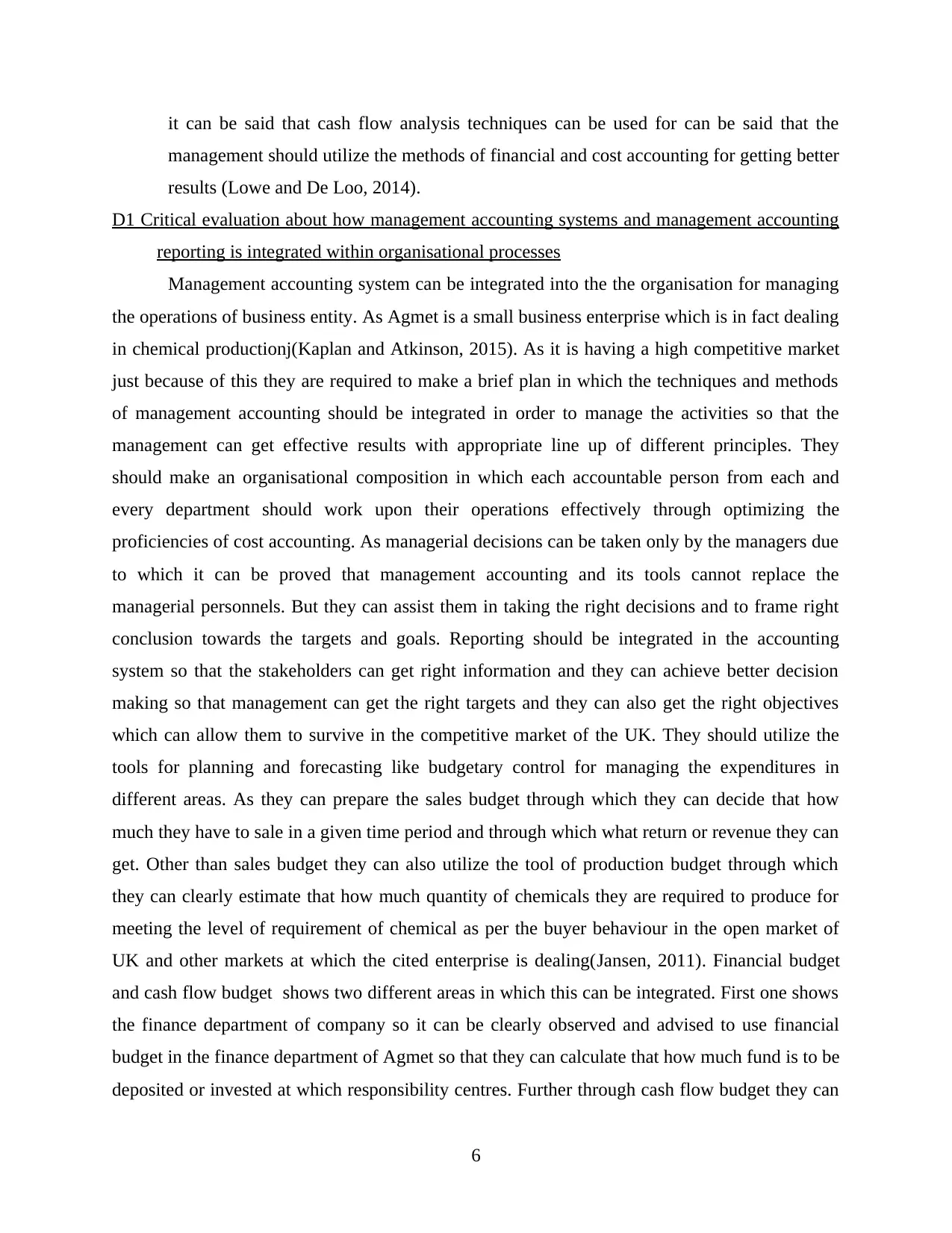
it can be said that cash flow analysis techniques can be used for can be said that the
management should utilize the methods of financial and cost accounting for getting better
results (Lowe and De Loo, 2014).
D1 Critical evaluation about how management accounting systems and management accounting
reporting is integrated within organisational processes
Management accounting system can be integrated into the the organisation for managing
the operations of business entity. As Agmet is a small business enterprise which is in fact dealing
in chemical productionj(Kaplan and Atkinson, 2015). As it is having a high competitive market
just because of this they are required to make a brief plan in which the techniques and methods
of management accounting should be integrated in order to manage the activities so that the
management can get effective results with appropriate line up of different principles. They
should make an organisational composition in which each accountable person from each and
every department should work upon their operations effectively through optimizing the
proficiencies of cost accounting. As managerial decisions can be taken only by the managers due
to which it can be proved that management accounting and its tools cannot replace the
managerial personnels. But they can assist them in taking the right decisions and to frame right
conclusion towards the targets and goals. Reporting should be integrated in the accounting
system so that the stakeholders can get right information and they can achieve better decision
making so that management can get the right targets and they can also get the right objectives
which can allow them to survive in the competitive market of the UK. They should utilize the
tools for planning and forecasting like budgetary control for managing the expenditures in
different areas. As they can prepare the sales budget through which they can decide that how
much they have to sale in a given time period and through which what return or revenue they can
get. Other than sales budget they can also utilize the tool of production budget through which
they can clearly estimate that how much quantity of chemicals they are required to produce for
meeting the level of requirement of chemical as per the buyer behaviour in the open market of
UK and other markets at which the cited enterprise is dealing(Jansen, 2011). Financial budget
and cash flow budget shows two different areas in which this can be integrated. First one shows
the finance department of company so it can be clearly observed and advised to use financial
budget in the finance department of Agmet so that they can calculate that how much fund is to be
deposited or invested at which responsibility centres. Further through cash flow budget they can
6
management should utilize the methods of financial and cost accounting for getting better
results (Lowe and De Loo, 2014).
D1 Critical evaluation about how management accounting systems and management accounting
reporting is integrated within organisational processes
Management accounting system can be integrated into the the organisation for managing
the operations of business entity. As Agmet is a small business enterprise which is in fact dealing
in chemical productionj(Kaplan and Atkinson, 2015). As it is having a high competitive market
just because of this they are required to make a brief plan in which the techniques and methods
of management accounting should be integrated in order to manage the activities so that the
management can get effective results with appropriate line up of different principles. They
should make an organisational composition in which each accountable person from each and
every department should work upon their operations effectively through optimizing the
proficiencies of cost accounting. As managerial decisions can be taken only by the managers due
to which it can be proved that management accounting and its tools cannot replace the
managerial personnels. But they can assist them in taking the right decisions and to frame right
conclusion towards the targets and goals. Reporting should be integrated in the accounting
system so that the stakeholders can get right information and they can achieve better decision
making so that management can get the right targets and they can also get the right objectives
which can allow them to survive in the competitive market of the UK. They should utilize the
tools for planning and forecasting like budgetary control for managing the expenditures in
different areas. As they can prepare the sales budget through which they can decide that how
much they have to sale in a given time period and through which what return or revenue they can
get. Other than sales budget they can also utilize the tool of production budget through which
they can clearly estimate that how much quantity of chemicals they are required to produce for
meeting the level of requirement of chemical as per the buyer behaviour in the open market of
UK and other markets at which the cited enterprise is dealing(Jansen, 2011). Financial budget
and cash flow budget shows two different areas in which this can be integrated. First one shows
the finance department of company so it can be clearly observed and advised to use financial
budget in the finance department of Agmet so that they can calculate that how much fund is to be
deposited or invested at which responsibility centres. Further through cash flow budget they can
6
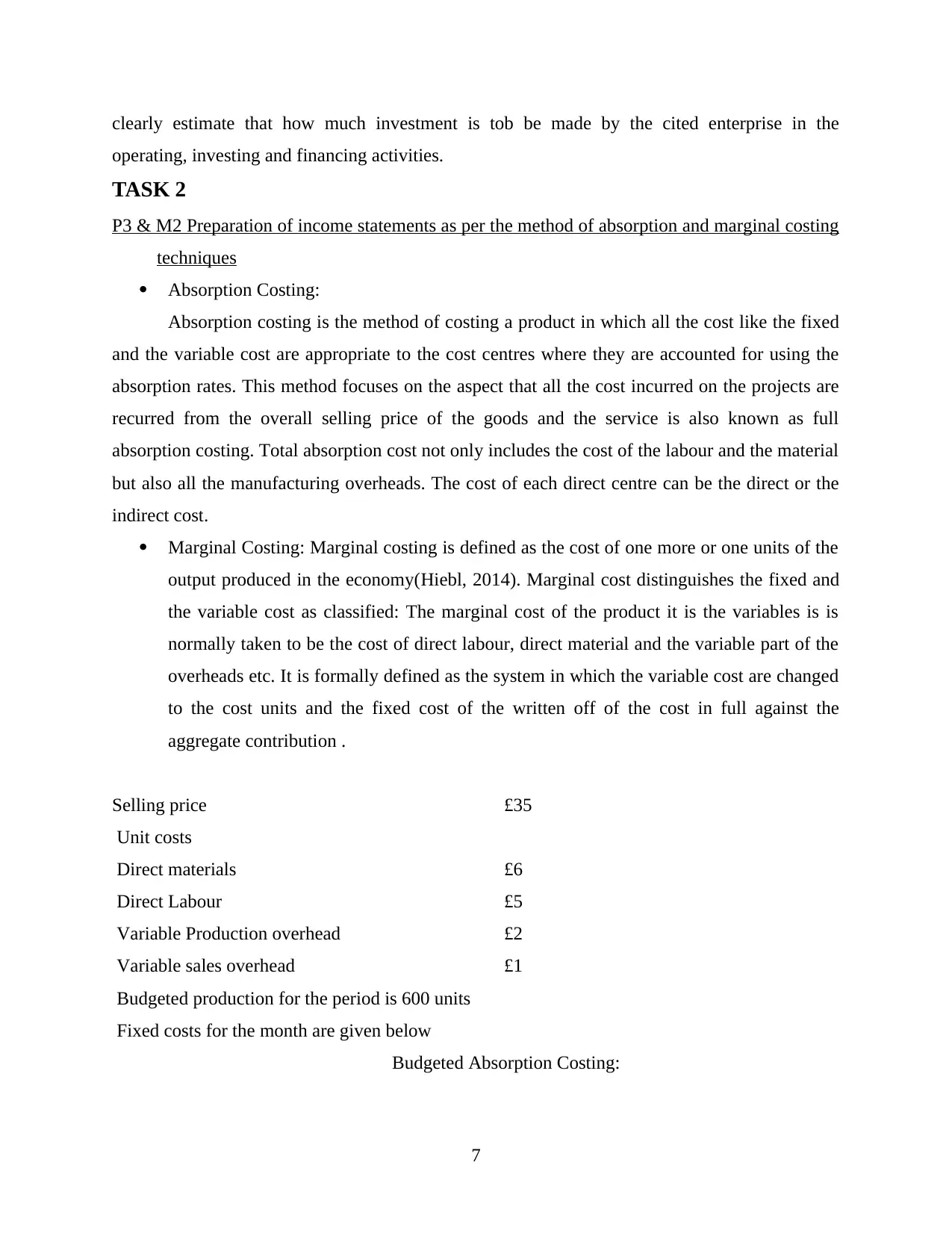
clearly estimate that how much investment is tob be made by the cited enterprise in the
operating, investing and financing activities.
TASK 2
P3 & M2 Preparation of income statements as per the method of absorption and marginal costing
techniques
Absorption Costing:
Absorption costing is the method of costing a product in which all the cost like the fixed
and the variable cost are appropriate to the cost centres where they are accounted for using the
absorption rates. This method focuses on the aspect that all the cost incurred on the projects are
recurred from the overall selling price of the goods and the service is also known as full
absorption costing. Total absorption cost not only includes the cost of the labour and the material
but also all the manufacturing overheads. The cost of each direct centre can be the direct or the
indirect cost.
Marginal Costing: Marginal costing is defined as the cost of one more or one units of the
output produced in the economy(Hiebl, 2014). Marginal cost distinguishes the fixed and
the variable cost as classified: The marginal cost of the product it is the variables is is
normally taken to be the cost of direct labour, direct material and the variable part of the
overheads etc. It is formally defined as the system in which the variable cost are changed
to the cost units and the fixed cost of the written off of the cost in full against the
aggregate contribution .
Selling price £35
Unit costs
Direct materials £6
Direct Labour £5
Variable Production overhead £2
Variable sales overhead £1
Budgeted production for the period is 600 units
Fixed costs for the month are given below
Budgeted Absorption Costing:
7
operating, investing and financing activities.
TASK 2
P3 & M2 Preparation of income statements as per the method of absorption and marginal costing
techniques
Absorption Costing:
Absorption costing is the method of costing a product in which all the cost like the fixed
and the variable cost are appropriate to the cost centres where they are accounted for using the
absorption rates. This method focuses on the aspect that all the cost incurred on the projects are
recurred from the overall selling price of the goods and the service is also known as full
absorption costing. Total absorption cost not only includes the cost of the labour and the material
but also all the manufacturing overheads. The cost of each direct centre can be the direct or the
indirect cost.
Marginal Costing: Marginal costing is defined as the cost of one more or one units of the
output produced in the economy(Hiebl, 2014). Marginal cost distinguishes the fixed and
the variable cost as classified: The marginal cost of the product it is the variables is is
normally taken to be the cost of direct labour, direct material and the variable part of the
overheads etc. It is formally defined as the system in which the variable cost are changed
to the cost units and the fixed cost of the written off of the cost in full against the
aggregate contribution .
Selling price £35
Unit costs
Direct materials £6
Direct Labour £5
Variable Production overhead £2
Variable sales overhead £1
Budgeted production for the period is 600 units
Fixed costs for the month are given below
Budgeted Absorption Costing:
7
⊘ This is a preview!⊘
Do you want full access?
Subscribe today to unlock all pages.

Trusted by 1+ million students worldwide
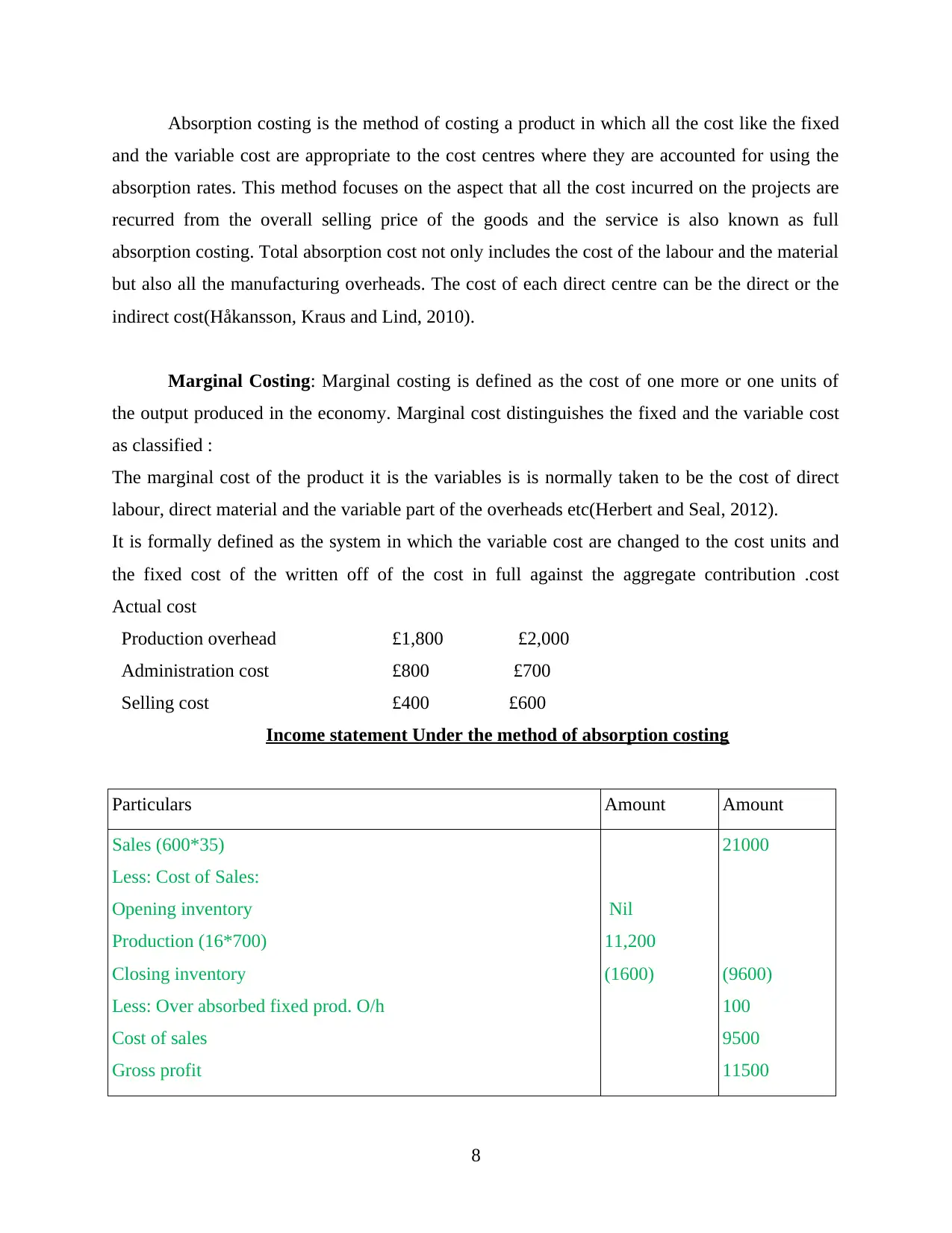
Absorption costing is the method of costing a product in which all the cost like the fixed
and the variable cost are appropriate to the cost centres where they are accounted for using the
absorption rates. This method focuses on the aspect that all the cost incurred on the projects are
recurred from the overall selling price of the goods and the service is also known as full
absorption costing. Total absorption cost not only includes the cost of the labour and the material
but also all the manufacturing overheads. The cost of each direct centre can be the direct or the
indirect cost(Håkansson, Kraus and Lind, 2010).
Marginal Costing: Marginal costing is defined as the cost of one more or one units of
the output produced in the economy. Marginal cost distinguishes the fixed and the variable cost
as classified :
The marginal cost of the product it is the variables is is normally taken to be the cost of direct
labour, direct material and the variable part of the overheads etc(Herbert and Seal, 2012).
It is formally defined as the system in which the variable cost are changed to the cost units and
the fixed cost of the written off of the cost in full against the aggregate contribution .cost
Actual cost
Production overhead £1,800 £2,000
Administration cost £800 £700
Selling cost £400 £600
Income statement Under the method of absorption costing
Particulars Amount Amount
Sales (600*35)
Less: Cost of Sales:
Opening inventory
Production (16*700)
Closing inventory
Less: Over absorbed fixed prod. O/h
Cost of sales
Gross profit
Nil
11,200
(1600)
21000
(9600)
100
9500
11500
8
and the variable cost are appropriate to the cost centres where they are accounted for using the
absorption rates. This method focuses on the aspect that all the cost incurred on the projects are
recurred from the overall selling price of the goods and the service is also known as full
absorption costing. Total absorption cost not only includes the cost of the labour and the material
but also all the manufacturing overheads. The cost of each direct centre can be the direct or the
indirect cost(Håkansson, Kraus and Lind, 2010).
Marginal Costing: Marginal costing is defined as the cost of one more or one units of
the output produced in the economy. Marginal cost distinguishes the fixed and the variable cost
as classified :
The marginal cost of the product it is the variables is is normally taken to be the cost of direct
labour, direct material and the variable part of the overheads etc(Herbert and Seal, 2012).
It is formally defined as the system in which the variable cost are changed to the cost units and
the fixed cost of the written off of the cost in full against the aggregate contribution .cost
Actual cost
Production overhead £1,800 £2,000
Administration cost £800 £700
Selling cost £400 £600
Income statement Under the method of absorption costing
Particulars Amount Amount
Sales (600*35)
Less: Cost of Sales:
Opening inventory
Production (16*700)
Closing inventory
Less: Over absorbed fixed prod. O/h
Cost of sales
Gross profit
Nil
11,200
(1600)
21000
(9600)
100
9500
11500
8
Paraphrase This Document
Need a fresh take? Get an instant paraphrase of this document with our AI Paraphraser
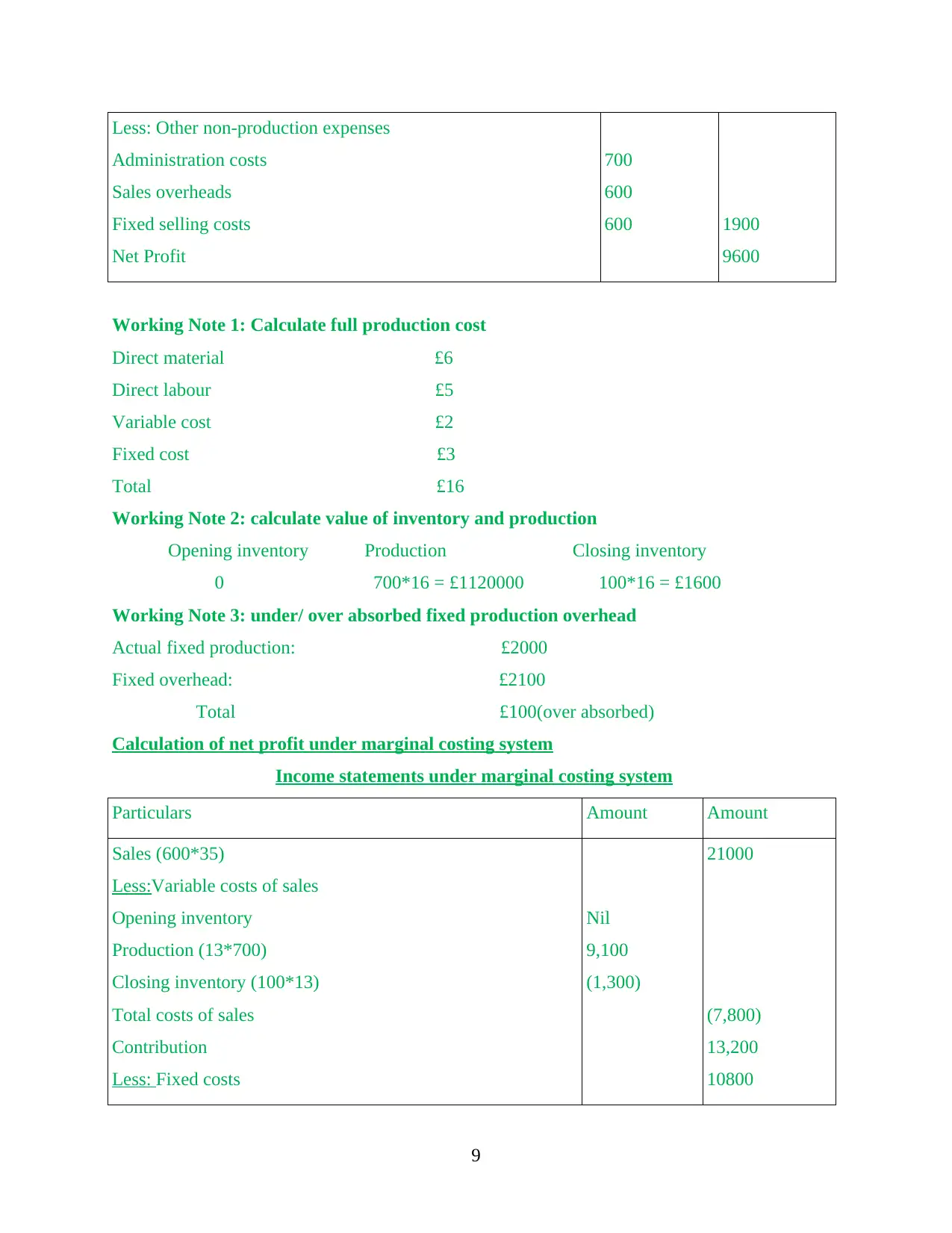
Less: Other non-production expenses
Administration costs
Sales overheads
Fixed selling costs
Net Profit
700
600
600 1900
9600
Working Note 1: Calculate full production cost
Direct material £6
Direct labour £5
Variable cost £2
Fixed cost £3
Total £16
Working Note 2: calculate value of inventory and production
Opening inventory Production Closing inventory
0 700*16 = £1120000 100*16 = £1600
Working Note 3: under/ over absorbed fixed production overhead
Actual fixed production: £2000
Fixed overhead: £2100
Total £100(over absorbed)
Calculation of net profit under marginal costing system
Income statements under marginal costing system
Particulars Amount Amount
Sales (600*35)
Less:Variable costs of sales
Opening inventory
Production (13*700)
Closing inventory (100*13)
Total costs of sales
Contribution
Less: Fixed costs
Nil
9,100
(1,300)
21000
(7,800)
13,200
10800
9
Administration costs
Sales overheads
Fixed selling costs
Net Profit
700
600
600 1900
9600
Working Note 1: Calculate full production cost
Direct material £6
Direct labour £5
Variable cost £2
Fixed cost £3
Total £16
Working Note 2: calculate value of inventory and production
Opening inventory Production Closing inventory
0 700*16 = £1120000 100*16 = £1600
Working Note 3: under/ over absorbed fixed production overhead
Actual fixed production: £2000
Fixed overhead: £2100
Total £100(over absorbed)
Calculation of net profit under marginal costing system
Income statements under marginal costing system
Particulars Amount Amount
Sales (600*35)
Less:Variable costs of sales
Opening inventory
Production (13*700)
Closing inventory (100*13)
Total costs of sales
Contribution
Less: Fixed costs
Nil
9,100
(1,300)
21000
(7,800)
13,200
10800
9
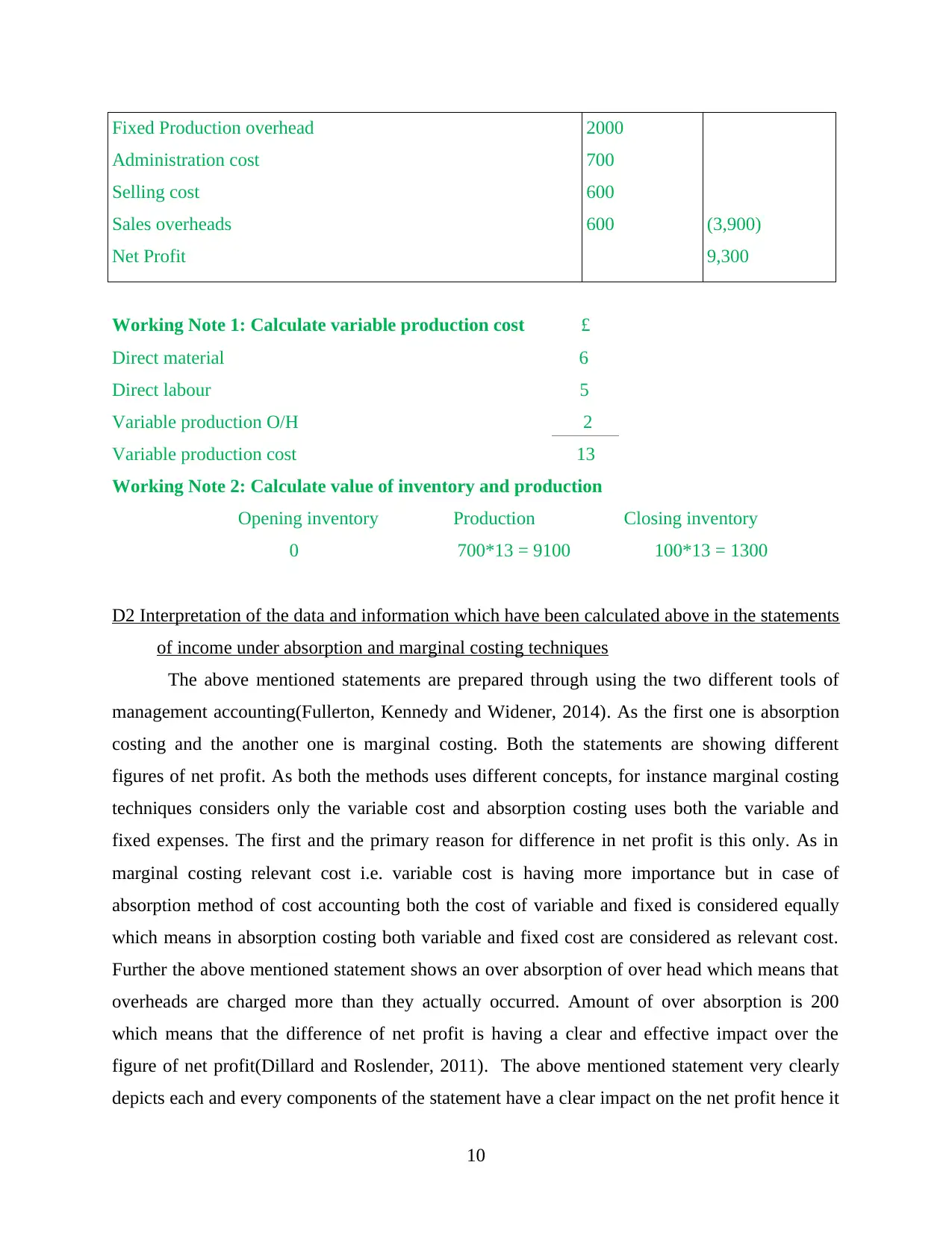
Fixed Production overhead
Administration cost
Selling cost
Sales overheads
Net Profit
2000
700
600
600 (3,900)
9,300
Working Note 1: Calculate variable production cost £
Direct material 6
Direct labour 5
Variable production O/H 2
Variable production cost 13
Working Note 2: Calculate value of inventory and production
Opening inventory Production Closing inventory
0 700*13 = 9100 100*13 = 1300
D2 Interpretation of the data and information which have been calculated above in the statements
of income under absorption and marginal costing techniques
The above mentioned statements are prepared through using the two different tools of
management accounting(Fullerton, Kennedy and Widener, 2014). As the first one is absorption
costing and the another one is marginal costing. Both the statements are showing different
figures of net profit. As both the methods uses different concepts, for instance marginal costing
techniques considers only the variable cost and absorption costing uses both the variable and
fixed expenses. The first and the primary reason for difference in net profit is this only. As in
marginal costing relevant cost i.e. variable cost is having more importance but in case of
absorption method of cost accounting both the cost of variable and fixed is considered equally
which means in absorption costing both variable and fixed cost are considered as relevant cost.
Further the above mentioned statement shows an over absorption of over head which means that
overheads are charged more than they actually occurred. Amount of over absorption is 200
which means that the difference of net profit is having a clear and effective impact over the
figure of net profit(Dillard and Roslender, 2011). The above mentioned statement very clearly
depicts each and every components of the statement have a clear impact on the net profit hence it
10
Administration cost
Selling cost
Sales overheads
Net Profit
2000
700
600
600 (3,900)
9,300
Working Note 1: Calculate variable production cost £
Direct material 6
Direct labour 5
Variable production O/H 2
Variable production cost 13
Working Note 2: Calculate value of inventory and production
Opening inventory Production Closing inventory
0 700*13 = 9100 100*13 = 1300
D2 Interpretation of the data and information which have been calculated above in the statements
of income under absorption and marginal costing techniques
The above mentioned statements are prepared through using the two different tools of
management accounting(Fullerton, Kennedy and Widener, 2014). As the first one is absorption
costing and the another one is marginal costing. Both the statements are showing different
figures of net profit. As both the methods uses different concepts, for instance marginal costing
techniques considers only the variable cost and absorption costing uses both the variable and
fixed expenses. The first and the primary reason for difference in net profit is this only. As in
marginal costing relevant cost i.e. variable cost is having more importance but in case of
absorption method of cost accounting both the cost of variable and fixed is considered equally
which means in absorption costing both variable and fixed cost are considered as relevant cost.
Further the above mentioned statement shows an over absorption of over head which means that
overheads are charged more than they actually occurred. Amount of over absorption is 200
which means that the difference of net profit is having a clear and effective impact over the
figure of net profit(Dillard and Roslender, 2011). The above mentioned statement very clearly
depicts each and every components of the statement have a clear impact on the net profit hence it
10
⊘ This is a preview!⊘
Do you want full access?
Subscribe today to unlock all pages.

Trusted by 1+ million students worldwide
1 out of 20
Related Documents
Your All-in-One AI-Powered Toolkit for Academic Success.
+13062052269
info@desklib.com
Available 24*7 on WhatsApp / Email
![[object Object]](/_next/static/media/star-bottom.7253800d.svg)
Unlock your academic potential
Copyright © 2020–2025 A2Z Services. All Rights Reserved. Developed and managed by ZUCOL.





